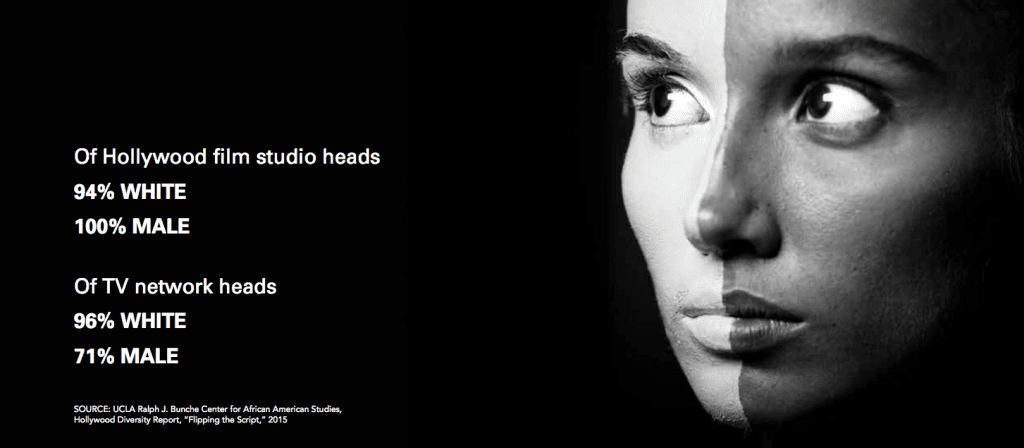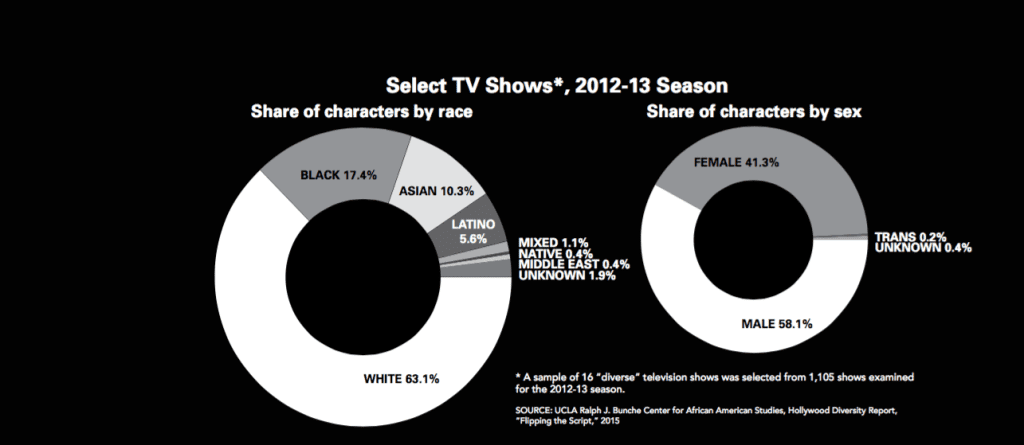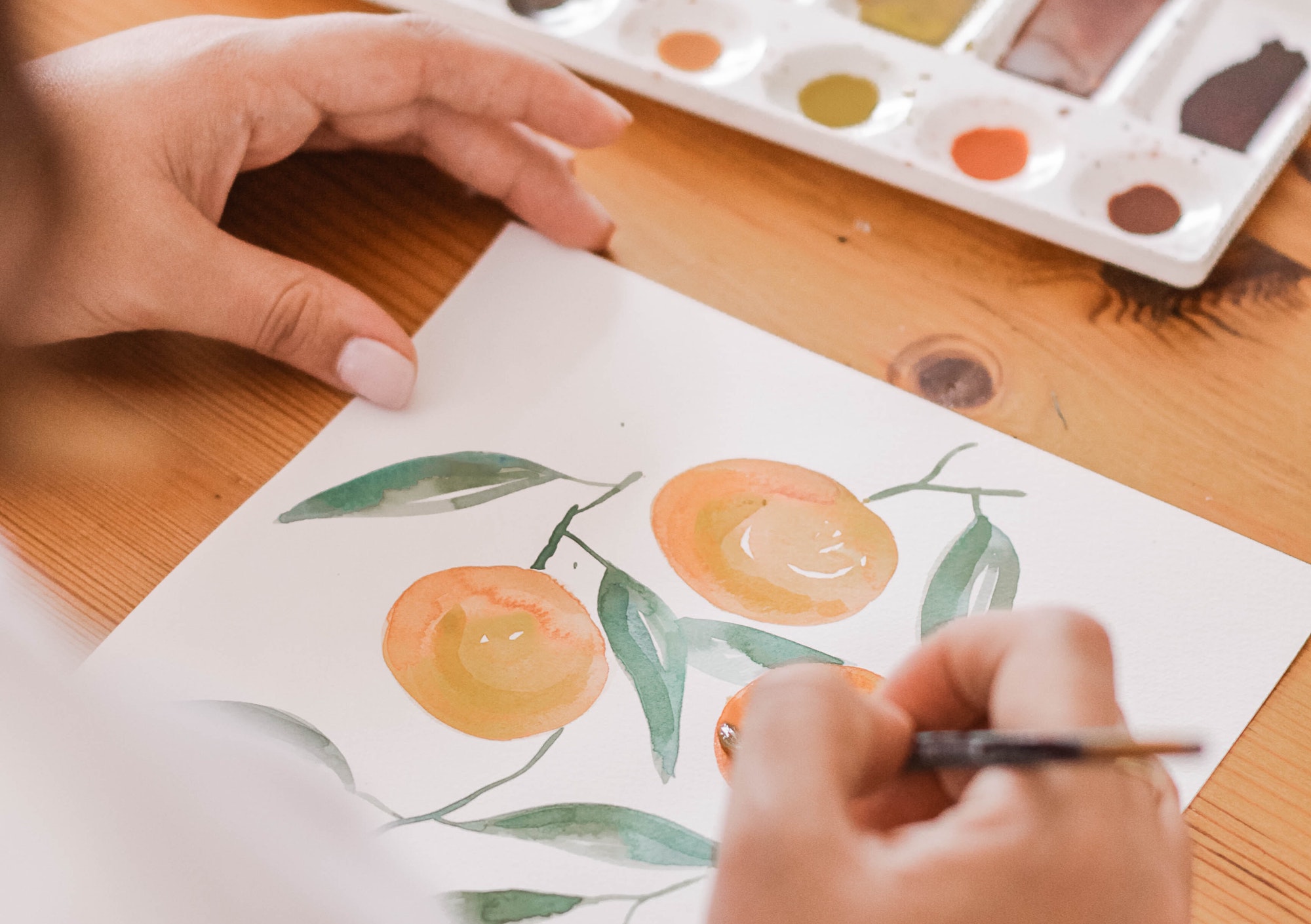Statistics show a stark lack of minorities and females throughout the film and TV industry.
Each year, the Academy Awards celebrates filmmaking at its finest. Winning an Oscar elevates the reputation of recipients, who are universally recognized as masters of their craft.
Yet this year, when Common and John Legend’s song “Glory” from the film “Selma” won the Oscar for Best Original Song, it represented only the 32nd time in 87 years that a black person has held an Oscar on Hollywood’s biggest stage—out of more than 2,900 winners.
In today’s global community, where various ethnicities work, socialize and live together, why does the entertainment industry’s biggest award suffer from a lack of diversity?
Of Hollywood film studio heads, 94 percent are white and 100 percent are male; of TV network heads, 96 are white and 71 percent are male, according to the 2015 Hollywood Diversity Report, “Flipping the Script,” released by the Ralph J. Bunche Center for African American Studies at UCLA. Among filmmakers, directors and show creators, the minority numbers were likewise strikingly low.
 Dr. Darnell Hunt, director of the Ralph J. Bunche Center for African American Studies, believes this lack of diversity developed out of both the structure and nature of the industry.
Dr. Darnell Hunt, director of the Ralph J. Bunche Center for African American Studies, believes this lack of diversity developed out of both the structure and nature of the industry.
“Throughout [the] history of industry, it’s been rich white men [who] have dominated the major positions in front of and behind the camera,” Hunt said. “It’s high risk: most TV shows fail the first year; most movies underperform.”

Determined to beat the low odds of success, he said, these men try to “hedge their bets” by surrounding themselves with people they feel comfortable with, who look like them and share similar experiences.
“This reproduces the dominance of white men in the industry over time and makes it really hard for women and minorities to break in in meaningful ways, particularly in decision-making positions,” he said.
While the diversity divide is a problem in both the film and TV industries, it’s more severe in film, according to Hunt. Television is making some progress—witness the success of “Empire,” “Jane the Virgin” and “How To Get Away With Murder.”
Indeed, as Hunt said, “audiences are hungry for diverse content” and are thus “voting with their eyeballs.”
The most compelling result from the report may be the connection between diversity and the bottom line.
“Films and TV shows that reflect America’s diversity on average did better,” Hunt said. “That gives me confidence that this is a very real phenomenon that we need to pay attention to.”
To keep the momentum growing in television and bring it into film, all limbs of the industry have to be involved. “The talent agencies have to do better, diversify their rosters [and] diversify their own ranks of agents; the networks have to do better—they have to demand content from the talent agencies and the studios; employment fields have to do better, have to increase the pipeline [of minority employees] coming into the directors’ guild and writers’ guild,” Hunt said.
As he explained, it’s hard to get a job if you haven’t already had one, and those first jobs tend to go to people show writers feel comfortable with.
Iranian-American comedian Maz Jobrani expected his Hollywood career to reflect his experience growing up in northern California, where he performed in school plays.
“At school, you get to play all kinds of parts [like] Little Abner and Batman,” he said. “I thought, ‘oh, this is how it’s going to be in Hollywood,’ but once you get there you realize that if you come from a certain background, you are going to be going out for certain types of parts. I started going out for auditions for these terrorist parts and that was kind of a wake-up call.”
After two terrorist roles, he told his agent “no more.” He said he didn’t want to be connected to a negative portrayal that could lead to repercussions here or abroad, but he was still determined to communicate to an audience.
- Support diversity in film and TV by watching movies and shows featuring the talents of a diverse cast and crew.
- Join programs, like Inner City Filmmakers, that educate young and diverse filmmakers in their craft.
- Download and share Deloitte University Press’ report “Diversity’s New Frontier” for tips on how to promote diversity in your workplace at dupress.com/articles/diversitys-new-frontier/.
- Contact producers and studio executives to let them know what you think.
“I think comedy can really do a good job of basically disarming people so they’re willing to listen to a message that’s different from what they’re used to listening to,” Jobrani said. “[It’s] a good way to get your message across and make it palatable.”
Jobrani used comedy in his recent book “I’m Not a Terrorist, But I’ve Played One On TV,” in his TED talk, “Did you hear the one about the Iranian-American?” and in his film, “Jimmy Vestvood, Amerikan Hero,” which won awards at the Austin Film Festival in 2014.
Like Hunt, Jobrani observed that Hollywood is a business, where the bottom line is what counts—and the audience chooses what to support.
To directly address the lack of access to the entertainment industry, Los Angeles-based Inner-City Filmmakers (ICF), is in its 22nd year of helping college-age young adults from minority families to learn industry skills and connect to internships and entry-level jobs.
To date, roughly 600 students have completed the ICF program, which was founded in 1993 by film editor Fred Heinrich and producer Stephania Lipner. Heinrich said about 60 percent of participants are now working in the industry.
ICF added fall and spring components to its schedule, in addition to the original eight-week summer program, which runs seven days a week for 12 hours per day with up to 35 students. Participants learn all aspects of filmmaking—writing, directing, camera work and editing—and work in teams to produce films. Each spring, IFC students are selected to attend the Sundance Film Festival.
“We hope they’re learning if you want to succeed you’ve got to really put in the effort, and you have to build connections,” Heinrich said. “We all have to learn to work together.”













